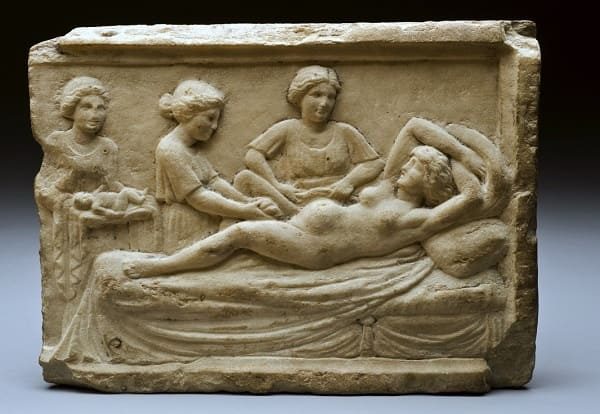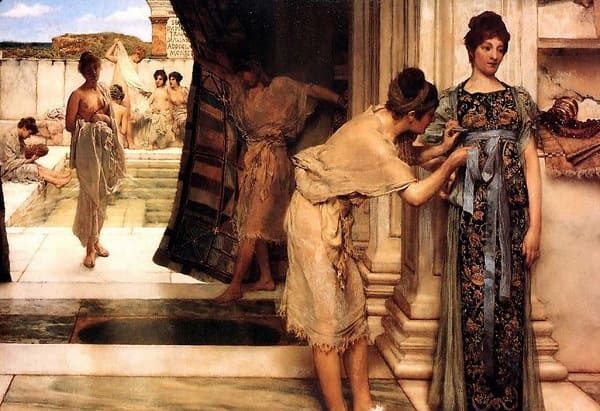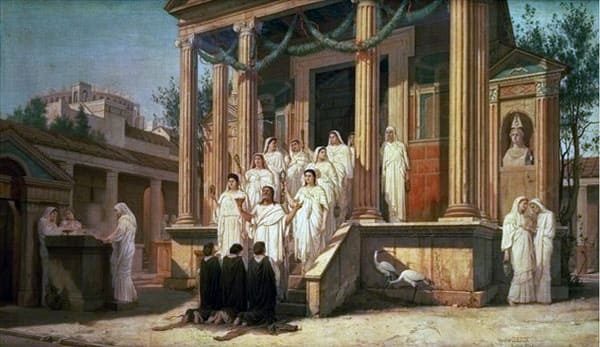For the people who are interested in the history of ancient times there is no surprise that there are many bizarre records about the inhabitants’ lifestyle, attitude and behavior. Here are some interesting facts about women in Ancient Rome.
Roman baby
The central figure of the Roman family was father – Patria potestas. He could take the child or give a command to kill him. The laws of the Twelve Tables in Rome even demanded the murder of every child deviating from the norm, because he could bring misfortune to the whole community. After their elimination, there was a rite of public redemption.
The first ritual in the life of a baby was the ritual of naming, which still retains significant. The Roman’s respect to the daughters’ naming was special.
Plutarch gave an interesting fact regarding the name assignment of a neonate written in the “Roman questions”: “Why are boys given a name on the ninth day from birth, and the girls on the eighth? Maybe girls are called before boys according to their nature: women grow, blossom and mature faster than men? ”
As for the name itself, the Roman woman had 2 names: family and personal. Unmarried women were usually called with the mention of the father’s name, and married — the husband’s one. Later women had simply a family name. If there were a number of Roman women in one family who had the same names, they were numbered: Claudia Tertius (third), Claudia Quinta (fifth), etc.
No sexual relations during the lactation period
Soranus, the scientist of the 2nd century, wrote that the milk of a wet nurse was preferential during the first days of a baby. He justified this by the fact that the mother may be exhausted to breastfeed. He also advised that a half-year-old infant should be switched to “proper” meal, such as bread soaked in wine.

Although there were specific rules for a nurse. She needed to observe the strict way of life: not to drink wine, eat food which was believed to promote lactation, for example, dill. The nurse could not have sexual relations.
Meanwhile, Cicero was disagreed and wrote that the children “suck the misconceptions of the wet nurse”.
Ancient Roman girls
There was quite short infancy for Roman girls – they were married starting since the age of 12-14. Due to high infant mortality rate, the young girls were expected to start giving birth as early as possible.
Every girl in the Roman Empire had a doll which it parted with before the wedding. The childhood farewell ceremony before the wedding included the offering of the beloved doll to the altar of the gods of the family and the home. Antique dolls of the Romans depicted an adult woman; these were depictions of the goddesses — Proserpine, Vesta or Venus.
As well as Egyptian women, the Roman were buried with their belongings. The dolls accompanied in the afterlife of their little mistresses. Archaeologists of Rome make the most famous finds of ancient Roman dolls.
In 1889 a sarcophagus of a girl of age 18 was discovered, the approximate date of burial is 170. The skull was turned to the left shoulder, where an elegant doll located. That was an ivory doll with hinged terms of body. On the doll’s finger there was a key to her treasure – a box with a small mirror and a cosmetic bag inside.
Strange cosmetics
Roman women strived for the perfection. The better women looks the richer her husband is. Roman women of fashion who tried to conform to the ideal of beauty often were ridiculed for it.

For instance, the Roman poet Ovid (43-17 years BC) joyfully sneered at the brunette woman for trying to make her homemade hair-dye: “I told you that you just need not wash off the paint, but now look at yourself — there is nothing to paint anymore.”
There is another brochure where the writer Juvenal (55-127 AD) tells us how a woman tried to make her hair lush until they became almost a haystack.
The ancient Roman women sought the ways to hide some skin shortcomings. Some recipes we can find quite “smart”, exclusively vegetarians made of lentils, honey, barley, lupine or dill.
Although others – horribly strange. The masks made of deer horns, feces of kingfishers, mice or crocodiles, placenta, bile, as well as of urine of calves, cows and mules. These ingredients were combined with hawthorn seeds, goose fat, basil juice, oregano, sulfur, honey and vinegar.
Masks with urine of mule were effective if used immediately after preparation. Other authors adverted the crocodile litter used as a blusher. The markets even sold tablets against the bad breath. They are intended primarily to kill the smell of alcohol.
Being an Ancient Roman wife
At the time of ancient Roman civilization – Period of Kings (625-510 before Christ), the women did not have any rights: fathers sold their daughters to marriage; meanwhile husbands bought wives for themselves by robbery or purchase. In the women, adultery prosecuted as a crime against the husband property and punished severely.
TOP-7 most famous women kings in ancient history
As for men – everything was different. As a sign of a strong friendship or hospitality or as a reward, a man could provide his wife for a one-night stand. Women could not resist the will of men.
One of the customs of Ancient Rome was eugenics:
The spouse sent his wife to a nobleman, and she was there until she got pregnant. Nevertheless, after childbirth, the head of the family was regarded as the father of the child, and not the biological one.
The scientists believe that since those times, this custom has been spread around the world. The less-status families resorted to it to improve their offspring at the genetic level.
Clothes as a sign of dignity
In Republican Rome, the social status of women increased positively. The Ancient Roman woman of that time, unlike the Greek woman, freely chose her husband; as mother of the family (mater familias), matron, revered by slaves, clients and children, she was the mistress of her house.

The signs of the dignity of a freeborn married woman were stola (stola – a long, spacious dress that was forbidden to be worn by prostitutes and women convicted of adultery) and a special head bandage (vitta).
Strict hierarchy of women
The utmost rank included all the female relatives of the ruler. These women could afford everything, but, of course, without violating the external standards of decency. They had to follow the fashion and always conform to it.
The second rank included women, who constituted the main asset of society. They were obliged to arrange receptions on a regular basis. These included high-ranking women, intelligent or influential. They had to follow the mode and take an active part in social life. However, they did not have the right to express their thoughts in public — they could certainly think, but they were forbidden to speak out and thereby agitate the public.
The third level included married women or matrons, as they were called. Unlike the first and the second level, they were much freer in their desires. They could accept an invitation or refuse it. They could either arrange receptions or not, and invite anyone to their heart’s content.
The fourth rank comprised those women who fell down in the eyes of society. This rank also included those who provoked authoritative women.
There was also the fifth rank in Ancient Roman society — it included all unmarried women, foreigners and plebeian women.
Vestal Virgins as a specific phenomenon
There was a special niche of society — Vestal Virgins. They were completely freed from the burden of secular life. Chosen for their role between the ages of six and ten, those women were delegated to serve the cult of Vesta for thirty years.

These famous priestesses were so remarkable, they had many privileges. They could be carried around the city as a royal; they also could save the life of one that had to be executed.
Vestal Virgins were fiduciary and extremely regarded, although the penalties for the faults were severe. This is said to have been because the people of Rome feared Vesta’s vengeance. It says that only twenty-two Vestals had broken the faith. Some faithless virgins were beaten to death. In late Rome, they were inhumed alive.
Three children – and you are free
The government encouraged boosting childbirth. For mothers who carried out the triple, the ВМС Trium liberorum (“the legal right of three children”) was awarded. So the brave women became free.
Are the wives of Roman Emperors poisoners?
The wives, Empresses, are represented as poisoners, as warrior women, and nothing could stop them on their path. It was recorded that Augustus’ wife, Livia, killed him after spending the whole life together. She covered the bane on the fruit that the emperor picked off the trees.
Meanwhile, Agrippina was said to have poisoned her husband Claudius by adding a toxic to his dinner. Messalina, another Claudius’s wife, systematically killed her enemies, and also had a reputation of a sexually insatiable woman.
Of course, we can believe that the bunch of those stories could be conjectures that were spread by people being concerned their closeness position to the governance. So those important women played a role of ancient women kings in their own way.
The expression “Behind every successful man is a strong woman” truly describes the position of women of Ancient Rome.







